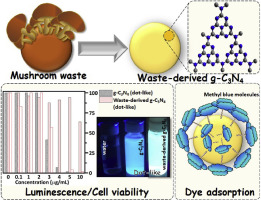当前位置:
X-MOL 学术
›
Mater. Chem. Phys.
›
论文详情
Our official English website, www.x-mol.net, welcomes your
feedback! (Note: you will need to create a separate account there.)
Mushroom waste-derived g-C3N4 for methyl blue adsorption and cytotoxic test for Chinese hamster ovary cells
Materials Chemistry and Physics ( IF 4.3 ) Pub Date : 2020-04-01 , DOI: 10.1016/j.matchemphys.2020.122715 Hung-Chun Yang , Ming-Wei Chao , Chung-Jung Chou , Ke-Hsuan Wang , Chechia Hu
Materials Chemistry and Physics ( IF 4.3 ) Pub Date : 2020-04-01 , DOI: 10.1016/j.matchemphys.2020.122715 Hung-Chun Yang , Ming-Wei Chao , Chung-Jung Chou , Ke-Hsuan Wang , Chechia Hu

|
Abstract In this study, a polymeric graphitic carbon nitride (g-C3N4) was prepared from melamine by adding mushroom waste. The waste-derived g-C3N4 sample exhibited improved adsorption efficiency for methyl blue (MB) with the increasing waste content. The enhanced adsorption efficiency could be attributed to the presence of the amorphous carbon domain in the waste-derived g-C3N4 structure and the reduced ratio of graphitic nitrogen in the tri-s-triazine unit of g-C3N4. MB adsorption using waste-derived g-C3N4 follows pseudo-second-order reaction kinetics, and can be represented by the Langmuir and Freundlich models, which suggested that the chemical states, graphitic degree, and surface properties of the waste-derived g-C3N4 greatly influenced the MB adsorption behavior. Compared to pristine g-C3N4, waste-derived g-C3N4 was relatively harmless and displayed high cell viability for Chinese hamster ovary cells (CHO-AS52), and showed intense luminescence under an excitation wavelength of 365 nm in the viewing cabinet. Our results demonstrated that the mushroom waste-derived g-C3N4 could be a green, facile, and effective material for many applications like dye removal, photocatalysis, bio-imaging, and as a raw material for the preparation of g-C3N4 dots.
更新日期:2020-04-01











































 京公网安备 11010802027423号
京公网安备 11010802027423号